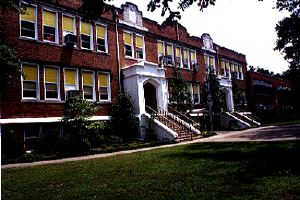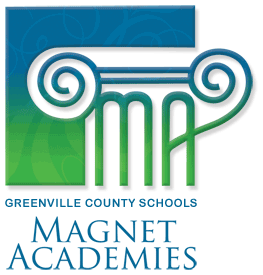History of Stone Academy

Dr. Charles Benjamin Stone and his wife, Eugenia Ann Earle, lived in Greenville from 1840 to 1886 on a large plantation covering much of the land from Main Street to and including part of East North Street, Rutherford Road, and Wade Hampton Blvd. Upon Dr. Stone's death in 1886, his five children inherited his estate. One of those children was Eugene Earle Stone.
Eugene Earle Stone was a prominent Greenville resident who fought skirmishes in the Civil war, loved literature, often quoted poetry, and was an excellent farmer and a devoted family man. Stone School was eventually built on land that he had owned. He sold the parcel to the Greenville School District Trustees in March of 1923 for $2.000 (probably discounted), with the agreement that the school's name would be "Stone."
But that came later.
Until 1914, there had been two schools for whites (Central and Oaklawn) and two for blacks (Allen and Union). In 1914 two new schools, Park and Pinkney, were built. All but one of these schools had seven grades. Central High School (later called Greenville High) had 10 grades until 1916, when it finally got the 11th grade. There was no twelfth grade. Forward-thinking educators envisioned schools which would operate exclusively for small pupils, so everyone would have a better chance.'
In May of 1917, construction began on the four-room schoolhouse on Stone Avenue. The school was to have opened in September, but construction was delayed for one month. The U.S. had just entered the war and troops had come to Greenville for training at Camp Sevier.
Soon the dream came true, and the first of these schools, Stone Primary School (Stone Ave. School) opened for its first small pupils. There were ninety-five students in grades one and two.
In 1919 Superintendent J.L. Mann proposed the building of a separate high school on Westfield Street, which meant that several new grammar schools would be needed to house the elementary pupils who had been combined with higher classes. After a successful bond election, there was a flurry of building in Greenville. Construction began on a building "at the upper end of Wilton Street." This school, paired with Stone Avenue Primary School, had fourteen rooms and cost $60,000. Work was completed and the school opened (probably) in the Fall of 1924.
Stone Avenue School continued to serve nearby residents until about 1942. It was vacant for awhile in 1943 and housed the "Stone Avenue Nursery" sometime in 1945. The original small school was sold in 1947 to Earle Street Baptist Church. It was named the Kiddie Crisp Building in honor of the many years of service of first grade teacher, Mrs. B. B. Crisp. Now newly remodeled, it still serves the community, housing Boy Scout Troop 30, a Vietnamese congregation, and church activities. This is likely the oldest surviving school building in the city.
Mrs. Eugenia Graff, daughter of the late Louis Henry Cary and niece of the late Eugene Earle Stone, has memories of the years she attended Stone Primary School on Stone Avenue and Stone Elementary School on Wilton Street.
"During the day we memorized things, read books, did drill and practices, had arithmetic matches on the board, and were in spelling bees. There were many musical performances and plays in which such dances as the minuet or the Virginia Reel were performed. Since there was no cafeteria, we brought a snack from home. I remember Miss Lucia Sloan, a maiden aunt of Laura Thomas, who trained her little dog to carry a goodie basket containing a doily and a cookie or a sandwich to Laura every day when she was at school."
Mr. James Mann, whose father was mayor of Greenville from 1929 to 1933, attended both Stone schools and was three years behind Eugenia. James remembers more about playing than what he did at school. "All the boys in the neighborhood liked to play football or roller skate while playing tin can hockey. All my brothers and sisters, and all my own children went to both Stone schools. The teachers were all good," said James as he remembered the past.
In 1955 there were 620 students and twenty teachers. After studying the Greenville community, Miss Elizabeth Morgan's class presented a spectacular musical play called "Yesterday, Today, and Tomorrow." This was one of the fun activities which went on in Miss Morgan's class as she integrated the arts even then. Miss Morgan, although retired, is still active in Greenville functions and has a wealth of information to share.
Stone Elementary School was the first Greenville elementary school to have a separate checkout library, and the first to use audio-visual aids extensively. In 1950 the library was built and classroom additions were constructed. In May of 1976 additional renovations were made.
From the early years to 2009, there have been six principals at Stone: G.W. Palmer until 1950; Morgan Arant from 1950-1980; Cecil Edwards from 1980-1984; Pat Borenstein from 1984 to 1988; Francis Allgood from 1988-1989; Dwight Hettinger from 1989 to 1993; and Edward Holliday from 1993 to 2016. Brett Vaughn became principal in 2016 and served until 2021. Suzanne Shouse became principal in 2021 and continues to serve in that role.
Students at Stone won the school's first Incentive Award in 1987-1988. In 1991, Mr. Charles Slate, Stone's PTA president, spearheaded a letter-writing campaign and organized speakers who were successful in keeping Stone Elementary open and stopped a proposed merger with Summit Drive, which would have resulted in one very large school with 1000 students. While in office, Mr. Slate contacted alumni from Stone, community members, and city officials for help cleaning up adjoining Croft Park. Mr. Dwight Hettinger enlisted help from the Rotary Club. Hettinger and SIC Chairman, Tom Faulkner, were also strong supporters of Stone's Community Partners, based on the Big Brother/Big Sister model, which paired families or members of families from different backgrounds. The school Community Partners program was effective in bringing the neighborhood together.
In 1995, under the leadership of principal, Ed Holliday, Stone became a magnet academy with the focus on the arts. Stone Academy of Communication Arts embarked on an exciting future. Drama and dance were added to the weekly related arts instruction, which already included visual arts, music, and physical education.
The program has been successful, with students enrolling from every part of the county. Since Stone has been a magnet school, many accomplishments have been made. Stone won a $10,000 Arts-in-Education grant four consecutive years, a $5,000 grant by the State Arts Commission, and was a four consecutive year School Incentive Award winner for improving over each previous year. (That program is no longer in place.) The South Carolina Arts Commission has designated Stone Academy as a model Arts in the Basic Curriculum (ABC) site. Stone's writing program received recognition for three consecutive years as an exemplary writing program. Stone entered the exemplary writing Hall of Fame in 2000.
Increasing enrollment as a result of the magnet program again necessitated the expansion of the facilities. The various additions to the original building were demolished and a new building constructed behind and attached to the main building. The front of the school moved to the North side of the block. The new portion of the school contains the main office, a gymnasium, a cafetorium, a media center, a computer lab, individual classrooms with grade level conference rooms, and other rooms. The original building is now the arts wing, housing art, music, strings, band, piano, and the Challenge program.
Following the extensive rebuild/remodel, the landscaping was in need of serious attention. Several projects have taken place to improve the grounds, as well as adjacent Croft Park. In May of 2004, Kaboom selected Croft Park for a major playground improvement project. Fifth grade student council members chose their favorite from three different plans for the central play system. That includes a slide and climbing wall, among other activities. Home Depot provided volunteers and materials for a workday, and Chic-Fil-A brought lunch. Over fifty volunteers constructed the piece. The city of Greenville helped out by grading the park, building low retaining walls along sidewalks to contain the mulch, and removing the old play construct to be placed at a later date in the newly renovated kindergarten play area. In the summer of 2004, the kindergarten playground area was improved, thanks to the efforts of Jim and Christi Bailey. The ground was leveled and grass planted, and a mulched area built and fenced in to contain the relocated play equipment. Now kindergarteners have a nice big area all their own that is fun and safe.
Christi Bailey didn't stop there. She continued landscape improvements by recruiting architect Dabney Peeples to donate a plan for the interior courtyard garden. Her vision was to incorporate science activities, such as composting. That has indeed happened. Classes have planted basil and made pesto sauce that the cafeteria served them for lunch, and collards, which were harvested and donated to a women's shelter. Thanks to the SIC and particularly Carolyn Henry, whose efforts have made these projects possible. In the Spring of 2007, another aspect of the garden was completed. Amy MacPhee, a parent and school therapist, supervised the painting of a mural at the "hidden" entrance to the garden. She employed many of the special ed students to help with the art work. Soon after the completion of the mural the garden was dedicated and the major contributors honored. Those honorees were: Steven and Patrice Lineberger and Steve's company, Southern Greens, Christy and James Bailey, Lowes, and Dabney Peeples.
Early in the 2009-2010 school year, the Board of Trustees for Greenville County Schools voted to purchase additional land on the block for a new playground, as the new building used up all the school's land, and children were left with nowhere for running games. That land is now our new playground, with a walking/running track surrounding a play field. The PTA funded a the installation of a sprinkler system in August of 2010, to keep the grass and other plantings healthy.
The latest improvement effort has not yet officially begun. Tentative plans are in place to upgrade the original basement, turning the old cafeteria into a multipurpose room that could house meetings (including community meetings, an art gallery, and assemblies. Smaller rooms off the cafeteria could be used as studios for local artists-in-residence, who would interact with students all year long. You'll be hearing more about this later, as details emerge.
From that small four-room schoolhouse, to the large facility that is now called home, Stone Academy has not changed in its purpose to 'operate for small pupils so that everyone has a better chance.' Eugene Stone and his family would be proud.
-History courtesy of Mrs. Ginny Bennett, 4th Grade Teacher with contributions from Mrs. Margaret Love, parent and neighbor.
Thanks to Dr. Judy Bainbridge, for revisions based on her extensive research, 2009


